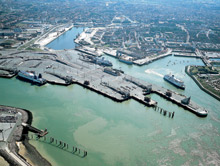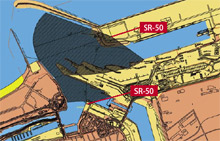 Situated on the most frequented shipping lanes in the world, Calais is the port, par excellence, for cross Channel links between the United Kingdom and the European mainland. The Port of Calais has all available modern facilities designed basically for the reception of large ferries and the loading and unloading of bulk cargo and diversified merchandise. It is linked to the European motorway network and a high-speed train assures direct access to Paris and Brussels within 90 minutes.
Situated on the most frequented shipping lanes in the world, Calais is the port, par excellence, for cross Channel links between the United Kingdom and the European mainland. The Port of Calais has all available modern facilities designed basically for the reception of large ferries and the loading and unloading of bulk cargo and diversified merchandise. It is linked to the European motorway network and a high-speed train assures direct access to Paris and Brussels within 90 minutes.
Freight carryings through the Port of Calais continued to grow throughout 2006 to increase by 11.8% on the previous year to a record 1,847,197 trucks. At the same time Calais passed the landmark figure of 40 million tons for freight traffic carried on the Calais-Dover route. Including general cargo this reached 41.5 million tons, an overall increase of 8.4% on 2005.
But Calais is not only an important harbour with regard to freight. In 2006, more than 11 million passengers passed through its facilities.
Preventing illegal Channel crossings and attacks
Making sure that the port is a secure area and that not only the passengers but also the vessels and their cargo are safe, is one of the task of the "The Calais Chamber of Commerce and Industry" which is the concessionary of the Port of Calais.
"Although since 1994 there is also a tunnel between the UK and the European mainland, the port of Calais has known a steady growth. The threat for a terrorist attack on the tunnel seems to be, for the authorities, a lot higher than having one here in our harbour", explains Mr. Hervé Couret, Port Facility Security officer and Manager of the Security Department. "However, we do not want to run the risk, that once certain individuals with the wrong ideas see how well the tunnel is secured, they come to the port because they think it is an easier target. Therefore, we are securing the port with all possible means so that it is a safe and secure place."
known a steady growth. The threat for a terrorist attack on the tunnel seems to be, for the authorities, a lot higher than having one here in our harbour", explains Mr. Hervé Couret, Port Facility Security officer and Manager of the Security Department. "However, we do not want to run the risk, that once certain individuals with the wrong ideas see how well the tunnel is secured, they come to the port because they think it is an easier target. Therefore, we are securing the port with all possible means so that it is a safe and secure place."
Being the major port between mainland Europe and the UK, a lot of people try to use the Port of Calais to enter the UK illegally. "We are trying to prevent that these people access one of the ferries that daily go to the UK. Not only because it is illegal to do so, but also because when they are trying to do this, they often bring themselves into great danger and can be killed in an accident. A harbour where giant ferries are going in and out on a continuous basis is a dangerous place to be swimming or floating around in a small rubber boat, particularly at night", explains Mr. Couret.
In order to monitor the activity in and around the port facilities during daytime, more than 40 CCTV cameras have been installed. They provide valuable information to the operators sitting in the control room of the Security Operations Centre.
Port facilities of Calais: a secure place, day and night
But what during the nighttime and in light fog, rain or snow when CCTV cameras cannot provide a clear image?
 "We started thinking of this about 6 years ago," explains Mr. Couret. "When we wrote the specifications for our security network, we clearly specified that, apart from CCTV cameras and other security measures like fences, we needed to have a system that could give us a clear image of the situation in the darkest of nights, in all weather conditions. At that point in time, thermal imaging cameras were still very expensive because in order to get a good range performance, a cooled detector was needed."
"We started thinking of this about 6 years ago," explains Mr. Couret. "When we wrote the specifications for our security network, we clearly specified that, apart from CCTV cameras and other security measures like fences, we needed to have a system that could give us a clear image of the situation in the darkest of nights, in all weather conditions. At that point in time, thermal imaging cameras were still very expensive because in order to get a good range performance, a cooled detector was needed."
"When I met Mr. Brice Kerrinckx of Alpha Photonics, distributors of FLIR Systems products in France and specialist in video for security and surveillance markets, last year on a trade show, he confirmed that this has changed. Today, thermal imaging cameras can be equipped with uncooled microbolometer detectors that provide excellent range performance. Not only are they a lot less expensive than cameras with a cooled detector. The fact that they do not contain any moving parts considerably reduces downtime and maintenance costs and increases their life cycle."
"One of the specifications for the thermal imaging cameras during the demonstration was that they needed to be able to see the head and shoulders of a person floating in the water at a distance of just over 400 metres. Mr. Kerrinckx came over for the demonstration and the FLIR Systems SR-50 thermal imaging cameras passed the test easily. So we decided to purchase two of them."
test easily. So we decided to purchase two of them."
"We mounted the two SR-50 thermal imaging cameras on a standard pan/tilt mechanism. In addition, they are mounted on a pole so that they can easily overlook an entire area. Thanks to their range performance, we can overlook the shore line from where people try to cross the Channel illegally."
Easy integration in the existing TCP/IP network
The two FLIR Systems SR-50 cameras were integrated in the security network of the port of Calais by Thales Security Systems. "Integrating the cameras into the local security network was a fairly easy job since FLIR Systems uses common standards", explains Olivier Margue of Thales Security Systems. "The SR-50 cameras were mounted on a standard pan/tilt and integrated in the existing network of security sensors. We completely integrated the SR-50 cameras into the TCP/IP network. From any client embedded workstation it is possible to see real time images. Just like all other cameras in the network, the thermal imaging cameras can easily be manipulated with a standard joystick."
Thermal imaging complements CCTV
"We are extremely happy with the two thermal imaging cameras", says Mr. Couret. "Not only do they give us a clear image at night, also during daylight, in light fog and rain where CCTV cameras are less efficient, they give us a comprehensive image of our port facilities. The people that are trying to gain an illegal access to the vessels in port also know that we have the thermal imaging cameras installed and are taking them into account. So just by being there, the cameras are already making the port a safer place."
International Ship and Port Facility Security (ISPS)
 "And there is another advantage. The thermal imaging cameras also help us to comply with the International Ship and Port Facility Security (ISPS) "regulations and ‘Le Touquet Treaty', a comprehensive set of measures to enhance the security of ships and port facilities, developed in response to the perceived threats to ships and port facilities in the wake of the 9/11 attacks in the United States, and in compliance with French legislation."
"And there is another advantage. The thermal imaging cameras also help us to comply with the International Ship and Port Facility Security (ISPS) "regulations and ‘Le Touquet Treaty', a comprehensive set of measures to enhance the security of ships and port facilities, developed in response to the perceived threats to ships and port facilities in the wake of the 9/11 attacks in the United States, and in compliance with French legislation."
"Today we are very happy with our thermal imaging cameras. Since the Calais Chamber of Commerce and Industry has serious expansions plans for the near future, we will have to evaluate in a later stage if and where we need to install more thermal imaging cameras", concludes Mr. Couret.
















